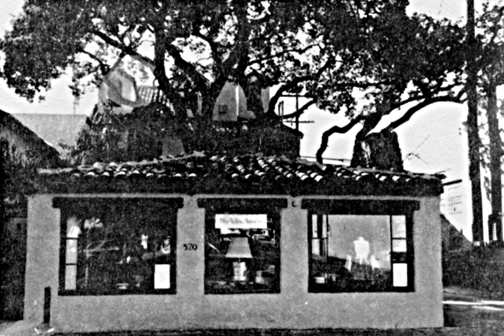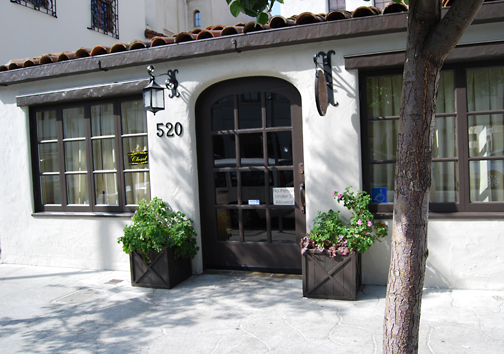 Palo Alto Stanford Heritage
Palo Alto Stanford Heritage |
 |
| Inventory photo | Photo taken May 9, 2008 |
The following is from the the National Register of Historic Places Inventory Nomination Form dated May 21, 1985 and the Historic Buildings Inventory as revised in 1985:
The structure is an irregularly massed, one- to three-story stucco clad "L" shaped complex in an eclectic Spanish Colonial Revival style with Bachelder tile, pieces of older buildings, interesting roof composition, and three strongly over-scaled dormers. It was one of the first Bay Area buildings to integrate natural surroundings into its design with its central courtyard built around a large oak tree. The exterior incorporated architectural and decorative spoilia salvaged from various sources, including materials from the 1906 earthquake-damaged Stanford University buildings.
At the front of the building was a one-story section with a stone chimney and Spanish tiled hipped roof. At the south side of this front section was an arch-covered entry (later removed) courtyard. The entry court led to an outside stone staircase with wrought iron railing that terminated at a second floor landing of the three-story rear section [528 Ramona]. One-half of the first and second floors at this rear section projected forward and was capped by a tiled shed roof.
The third floor of this rear section sits under the Spanish tiled gable roof. Three strongly over-scaled dormers and a stucco-clad tapered chimney pierced the roof. Randomly placed fenestration of varying proportions heightened visual interest on the north alley façade.
Over the years, there have been various remodelings. Currently [1985], the building is undergoing an extensive remodeling prompted by the removal of the diseased oak tree and the necessity of seismic upgrading. The one-story front section will return to its original façade composition with the entry door positioned in the center and the window returned to the south façade. The central courtyard will be filled in with a two-story Spanish tiled hipped roof addition, which will incorporate windows, doors, and wrought iron railings from the second floor façade of the rear section. The building has been continuously owned by descendants of the de Lemos family, and it is their intention to preserve the spirit of the original design in execution of the current remodeling.
As summarized in the Inventory, "The street-front building was reconstructed in 1985 to provide additional strength against earthquakes, the ancient, but dying courtyard oak was removed, and other portions of the complex were carefully rehabilitated to retain as much as possible of the original design and character. The picturesque commercial block demonstrates Pedro de Lemos's highly personal Spanish Colonial Revival idiom."
Pedro de Lemos, curator of the Stanford Museum, designed the Gotham Shop (which filled the entire first floor), at 520 Ramona Street. (In 1938, he designed the building directly across the street at 535 Ramona Street.) His talent as a craftsman as well as an architect is greatly in evidence here as it is in the Allied Arts buildings which he also designed. He emphasized and integrated color, texture, and line in each detail of his work—concrete sidewalks, carved doors, wrought iron balconies, handmade tile roofs, and small patios and fountains.
The structure surrounds a courtyard in which a native live oak grew, an innovative union of nature and architecture which Palo Altoans of his era called ridiculous.
Relics from the 1906 earthquake, salvaged from the Stanford campus, add interest to the courtyard entrance.
The entire 500 block of Ramona is lined with mutually supportive Spanish Colonial Revival structures, some of them containing interior courtyards. The most significant examples are designed by Pedro de Lemos or by Birge Clark.
The owner is De Lemos Properties.
This structure was built in 1925 and is a Category 1 on the Historic Buildings Inventory. The architect was Pedro de Lemos and the builder was Damant and Sons. The properties measures 80 by 100 feet and 50 by 100 feet.
Sources: Palo Alto Times 2/7/22, 9/12/25, 10/15/25, 1/6/26; Palo Alto Historical Association files; Birge Clark Commercial Inventory; book 548, Deeds, p. 294, 2/7/22, (Santa Clara Co. Recorder); AAUW, Exploring Palo Alto's Past; National Register of Historic Places Nomination papers, 1985; Historic America, HABS et al., Washington, DC, 1983, p. 343
E-mail us at either webmaster@pastheritage.org or president@pastheritage.org.
![]() Palo Alto Stanford Heritage—Dedicated to the preservation of Palo Alto's historic buildings.
Palo Alto Stanford Heritage—Dedicated to the preservation of Palo Alto's historic buildings.
Copyright © 2016 Palo Alto Stanford Heritage. All rights reserved.